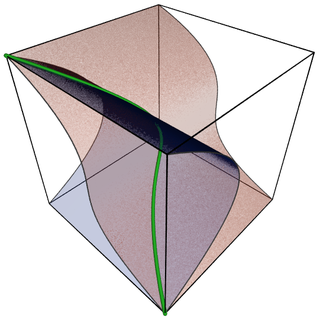In mathematics, especially in algebraic geometry, the étale homotopy type is an analogue of the homotopy type of topological spaces for algebraic varieties.

Algebraic geometry is a branch of mathematics, classically studying zeros of multivariate polynomials. Modern algebraic geometry is based on the use of abstract algebraic techniques, mainly from commutative algebra, for solving geometrical problems about these sets of zeros.
In topology and related branches of mathematics, a topological space may be defined as a set of points, along with a set of neighbourhoods for each point, satisfying a set of axioms relating points and neighbourhoods. The definition of a topological space relies only upon set theory and is the most general notion of a mathematical space that allows for the definition of concepts such as continuity, connectedness, and convergence. Other spaces, such as manifolds and metric spaces, are specializations of topological spaces with extra structures or constraints. Being so general, topological spaces are a central unifying notion and appear in virtually every branch of modern mathematics. The branch of mathematics that studies topological spaces in their own right is called point-set topology or general topology.

Algebraic varieties are the central objects of study in algebraic geometry. Classically, an algebraic variety is defined as the set of solutions of a system of polynomial equations over the real or complex numbers. Modern definitions generalize this concept in several different ways, while attempting to preserve the geometric intuition behind the original definition.
Roughly speaking, for a variety or scheme X, the idea is to consider étale coverings and to replace each connected component of U and the higher "intersections", i.e., fiber products, (n+1 copies of U, ) by a single point. This gives a simplicial set which captures some information related to X and the étale topology of it.
In mathematics, specifically in algebraic geometry, the fiber product of schemes is a fundamental construction. It has many interpretations and special cases. For example, the fiber product describes how an algebraic variety over one field determines a variety over a bigger field, or the pullback of a family of varieties, or a fiber of a family of varieties. Base change is a closely related notion.
In mathematics, a simplicial set is an object made up of "simplices" in a specific way. Simplicial sets are higher-dimensional generalizations of directed graphs, partially ordered sets and categories. Formally, a simplicial set may be defined as a contravariant functor from the simplex category to the category of sets. Simplicial sets were introduced in 1950 by Samuel Eilenberg and J. A. Zilber.
Slightly more precisely, it is in general necessary to work with étale hypercovers instead of the above simplicial scheme determined by a usual étale cover. Taking finer and finer hypercoverings (which is technically accomplished by working with the pro-object in simplicial sets determined by taking all hypercoverings), the resulting object is the étale homotopy type of X. Similarly to classical topology, it is able to recover much of the usual data related to the étale topology, in particular the étale fundamental group of the scheme and the étale cohomology of locally constant étale sheaves.
The étale or algebraic fundamental group is an analogue in algebraic geometry, for schemes, of the usual fundamental group of topological spaces.
In mathematics, the étale cohomology groups of an algebraic variety or scheme are algebraic analogues of the usual cohomology groups with finite coefficients of a topological space, introduced by Grothendieck in order to prove the Weil conjectures. Étale cohomology theory can be used to construct ℓ-adic cohomology, which is an example of a Weil cohomology theory in algebraic geometry. This has many applications, such as the proof of the Weil conjectures and the construction of representations of finite groups of Lie type.
In mathematics, a sheaf is a tool for systematically tracking locally defined data attached to the open sets of a topological space. The data can be restricted to smaller open sets, and the data assigned to an open set is equivalent to all collections of compatible data assigned to collections of smaller open sets covering the original one. For example, such data can consist of the rings of continuous or smooth real-valued functions defined on each open set. Sheaves are by design quite general and abstract objects, and their correct definition is rather technical. They are variously defined, for example, as sheaves of sets or sheaves of rings, depending on the type of data assigned to open sets.





